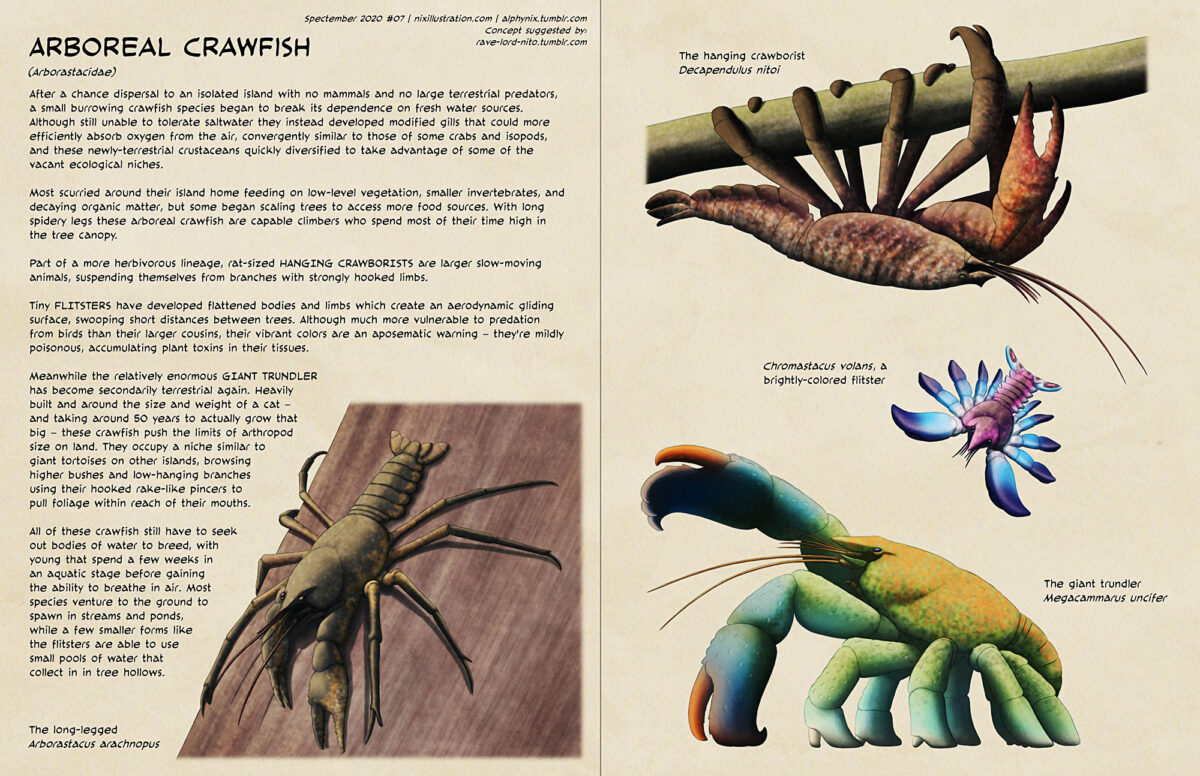Transcript for the text on the image under the cut:
PAGE 1
Spectember 2020 #07 | nixillustration.com | alphynix.tumblr.com
Concept suggested by:
rave-lord-nito.tumblr.com
Arboreal Crawfish
(Arborastacidae)
After a chance dispersal to an isolated island with no mammals and no large terrestrial predators, a small burrowing crawfish species began to break its dependence on fresh water sources. Although still unable to tolerate saltwater they instead developed modified gills that could more efficiently absorb oxygen from the air, convergently similar to those of some crabs and isopods, and these newly-terrestrial crustaceans quickly diversified to take advantage of some of the vacant ecological niches.
Most scurried around their island home feeding on low-level vegetation, smaller invertebrates, and decaying organic matter, but some began scaling trees to access more food sources. With long spidery legs these arboreal crawfish are capable climbers who spend most of their time high in the tree canopy.
Part of a more herbivorous lineage, rat-sized HANGING CRAWBORISTS are larger slow-moving animals, suspending themselves from branches with strongly hooked limbs.
Tiny FLITSTERS have developed flattened bodies and limbs which create an aerodynamic gliding surface, swooping short distances between trees. Although much more vulnerable to predation from birds than their larger cousins, their vibrant colors are an aposematic warning – they’re mildly poisonous, accumulating plant toxins in their tissues.
Meanwhile the relatively enormous GIANT TRUNDLER has become secondarily terrestrial again. Heavily built and around the size and weight of a cat – and taking around 50 years to actually grow that big – these crawfish push the limits of arthropod size on land. They occupy a niche similar to giant tortoises on other islands, browsing higher bushes and low-hanging branches, using their hooked rake-like pincers to pull foliage within reach of their mouths.
All of these crawfish still have to seek out bodies of water to breed, with young that spend a few weeks in an aquatic stage before gaining the ability to breathe in air. Most species venture to the ground to spawn in streams and ponds, while a few smaller forms like the flitsters are able to use small pools of water that collect in in tree hollows.
[Image: an arboreal crayfish with long spider-like legs climbing down a tree trunk.]
The long-legged crawborist Arborastacus arachnopus
PAGE 2
[Image: an arboreal crawfish hanging upside-down like a sloth. It has long legs with curving tips that hook over the tree branch.]
The hanging crawborist Decapendulus nitoi
[Image: a brightly-colored gliding arboreal crawfish. It has flattened pincers and limbs providing an aerodynamic wing-like surface, and a wide horizontal tail fin with eyespot markings.]
Chromastacus volans, a brightly-colored flitster
[Image: a large colorful ground crawfish. It has long curving rake-like pincers and thick chunky legs.]
The giant trundler Megacammarus uncifer

